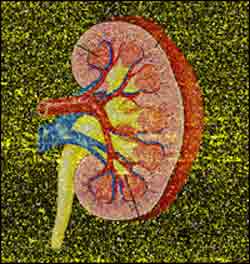A global view of gene expression in the aging kidney

Genome-wide analysis of aging in the human kidney. Photo illustration by Rebecca Sonu and Emily Crane.
Four years ago in Science, Stuart Kim, a Stanford University developmental biologist, made the case for describing the broad strokes of a complex physiological process before defining its mechanisms. “A powerful, top-down, holistic approach,” he wrote, “is to identify all of the components of a particular cellular process, so that one can define the global picture first and then use it as a framework to understand how the individual components of the process fit together.” To get a broad view of gene expression in the developing nematode, Kim’s lab turned to DNA microarray technology. In a new study, Kim and colleagues apply this same approach to the decidedly more complex problem of human aging and “present a molecular portrait” of the aging kidney.
Kidneys came from 74 patients, ranging in age from 27 to 92. Samples were extracted from donated kidneys or “meticulously harvested” from kidneys with localized disease to ensure only normal tissue was taken. Samples were obtained from two structures that are critical to kidney function: the renal cortex, which filters plasma, and the medulla, which alters urine composition to maintain fluid balance. Both deteriorate with age.
Kim and colleagues then used DNA microarrays to determine the activity of every gene in all the kidney samples. Of 33,000 known human genes on the microarray, 985 showed age-related changes.
Although cortex and medulla have different cell types and perform different functions, their genetic aging profile was very similar, suggesting a common aging mechanism operates in both structures. In fact, these mechanisms may function broadly, as most of the age-regulated kidney genes were also active in a wide range of human tissues. Other organisms appear to lack these changes, however, prompting the authors to argue that understanding aging in humans will require human subjects.
Most importantly, the genetic profile of the tissue samples correlated with the physiological decline of an aging kidney. An 81-year-old patient with an unusually healthy kidney had a molecular profile typical of someone much younger, while a 78-year-old with a less healthy kidney had the profile of a much older person. Using the power of functional genomics, this study has identified a set of genes that can serve as molecular markers for various stages of a deteriorating kidney. These gene sets can also serve as probes to shed light on the molecular pathways at work in the aging kidney, and possibly on the process of aging itself.
Media Contact
More Information:
http://www.plos.orgAll latest news from the category: Life Sciences and Chemistry
Articles and reports from the Life Sciences and chemistry area deal with applied and basic research into modern biology, chemistry and human medicine.
Valuable information can be found on a range of life sciences fields including bacteriology, biochemistry, bionics, bioinformatics, biophysics, biotechnology, genetics, geobotany, human biology, marine biology, microbiology, molecular biology, cellular biology, zoology, bioinorganic chemistry, microchemistry and environmental chemistry.
Newest articles

High-energy-density aqueous battery based on halogen multi-electron transfer
Traditional non-aqueous lithium-ion batteries have a high energy density, but their safety is compromised due to the flammable organic electrolytes they utilize. Aqueous batteries use water as the solvent for…

First-ever combined heart pump and pig kidney transplant
…gives new hope to patient with terminal illness. Surgeons at NYU Langone Health performed the first-ever combined mechanical heart pump and gene-edited pig kidney transplant surgery in a 54-year-old woman…

Biophysics: Testing how well biomarkers work
LMU researchers have developed a method to determine how reliably target proteins can be labeled using super-resolution fluorescence microscopy. Modern microscopy techniques make it possible to examine the inner workings…





















